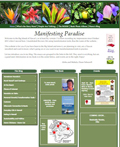 This month, Stacy and I kayaked the Kohala Ditch with Flumin’ Kohala. It was the six year anniversary of my move to the Big Island, and as my real estate agent, she was part of getting me here. I’m amazed that after six years of Paradise living, I’m still finding new things to do.
This month, Stacy and I kayaked the Kohala Ditch with Flumin’ Kohala. It was the six year anniversary of my move to the Big Island, and as my real estate agent, she was part of getting me here. I’m amazed that after six years of Paradise living, I’m still finding new things to do.
 The Kohala Ditch is a 22.5 mile manmade waterway that brought water to the sugar plantations on the Hawi (north) side of the island. (There’s another ditch on the Honokaʻa side, the Lower Hāmākua Ditch.) Sometimes the Japanese plantation workers who built it more than 110 years ago, only had to dig a channel into the earth and line it with hand-chiseled stones. Today those sections are mostly reinforced with concrete and covered with moss; it’s crumbling in some places.
The Kohala Ditch is a 22.5 mile manmade waterway that brought water to the sugar plantations on the Hawi (north) side of the island. (There’s another ditch on the Honokaʻa side, the Lower Hāmākua Ditch.) Sometimes the Japanese plantation workers who built it more than 110 years ago, only had to dig a channel into the earth and line it with hand-chiseled stones. Today those sections are mostly reinforced with concrete and covered with moss; it’s crumbling in some places.
 Other times they had to dig tunnels through solid rock with pick axes, occasionally blasting with dynamite. The water also had to be transported over deep gulches and streams. In those sections, they built elevated flumes to carry the water across. Today, the sugar plantations are gone, but the waterway remains, still delivering water to local farms.
Other times they had to dig tunnels through solid rock with pick axes, occasionally blasting with dynamite. The water also had to be transported over deep gulches and streams. In those sections, they built elevated flumes to carry the water across. Today, the sugar plantations are gone, but the waterway remains, still delivering water to local farms.
 We started our tour at the historic Kohala Ditch Company Building in Hawi. Our local guides, Austin and Mark, gave us flotation devices, head lamps, and a safety talk. This ecotour is a tranquil ride: no white-water, no shootin’ the rapids, only a 1% grade and a couple of bubbling dips. One of the FAQ’s on the website is, “I don’t know how to swim. Should I be concerned?” Answer: “If you should fall into the ditch, simply stand-up. The water is only knee deep.” I felt very safe throughout the experience.
We started our tour at the historic Kohala Ditch Company Building in Hawi. Our local guides, Austin and Mark, gave us flotation devices, head lamps, and a safety talk. This ecotour is a tranquil ride: no white-water, no shootin’ the rapids, only a 1% grade and a couple of bubbling dips. One of the FAQ’s on the website is, “I don’t know how to swim. Should I be concerned?” Answer: “If you should fall into the ditch, simply stand-up. The water is only knee deep.” I felt very safe throughout the experience.
 From the drop-off point, we took a 10 minute walk across an elevated 150 foot flume and then alongside the ditch before boarding the soft-sided kayaks. Those who have trouble walking, can be driven directly to the boarding point.
From the drop-off point, we took a 10 minute walk across an elevated 150 foot flume and then alongside the ditch before boarding the soft-sided kayaks. Those who have trouble walking, can be driven directly to the boarding point.
 The kayaks hold four people including one paddler and one person who steers. On tours where there are more customers, some may be asked to do one or the other job. Having chosen an early morning tour, Stacy and I were the only people. So we got the royal treatment, sitting in the middle of the kayak.
The kayaks hold four people including one paddler and one person who steers. On tours where there are more customers, some may be asked to do one or the other job. Having chosen an early morning tour, Stacy and I were the only people. So we got the royal treatment, sitting in the middle of the kayak.
 As we lazily floated down the ditch, we listened to birds in the trees. The noisy invasive coqui frogs have not yet made it up here, though we wouldn’t usually hear them until nightfall anyway. The sun filtered through the ohia trees, at times shining full force and sparkling on the water. This is a part of the Big Island that you wouldn’t ordinarily see, and I felt humbled to be here.
As we lazily floated down the ditch, we listened to birds in the trees. The noisy invasive coqui frogs have not yet made it up here, though we wouldn’t usually hear them until nightfall anyway. The sun filtered through the ohia trees, at times shining full force and sparkling on the water. This is a part of the Big Island that you wouldn’t ordinarily see, and I felt humbled to be here.
 The longest tunnel on the three miles of the tour is 1800 feet. Luckily, it was a straight shot and we could actually see the light at the end from the beginning. Other tunnels curved, and it was pitch dark all along the way, except for our head lamps. Some were so low that we had to lie back in the kayak to keep from hitting our heads. The whole tunnel experience was amazing. At times we could hear babbling water; other times it was completely silent except for the sounds we made.
The longest tunnel on the three miles of the tour is 1800 feet. Luckily, it was a straight shot and we could actually see the light at the end from the beginning. Other tunnels curved, and it was pitch dark all along the way, except for our head lamps. Some were so low that we had to lie back in the kayak to keep from hitting our heads. The whole tunnel experience was amazing. At times we could hear babbling water; other times it was completely silent except for the sounds we made.
 We also saw bits of history that the Japanese workers left: a mark chiseled into rock that indicated the passage of one month from the time they started that particular tunnel, and a slogan that cheered on the Japanese victory over the Russians in their 1905 war. In the 18 months it took to build the first 18 miles, 17 workers died.
We also saw bits of history that the Japanese workers left: a mark chiseled into rock that indicated the passage of one month from the time they started that particular tunnel, and a slogan that cheered on the Japanese victory over the Russians in their 1905 war. In the 18 months it took to build the first 18 miles, 17 workers died.
 Fresh-water prawns live in the ditch, introduced to Hawaiʻi from Tahiti in 1956. Austin brought a net to catch one. Apparently, the prawns’ hatched eggs drift down gulches and the ditch to enter the ocean where the little prawns grow by molting multiple times. Later, just like salmon, they swim back up the gulches or ditch to start the cycle all over again. After showing it to us, Austin released it back into the ditch.
Fresh-water prawns live in the ditch, introduced to Hawaiʻi from Tahiti in 1956. Austin brought a net to catch one. Apparently, the prawns’ hatched eggs drift down gulches and the ditch to enter the ocean where the little prawns grow by molting multiple times. Later, just like salmon, they swim back up the gulches or ditch to start the cycle all over again. After showing it to us, Austin released it back into the ditch.
 Floating across the seven flumes gave us a different view of the landscape, with peeks into the heavy growth of this tropical rain forest. Sometimes we could see waterfalls mauka (up mountain). Everywhere we floated, our guides pointed out the flora from native ferns and beautiful flowers to invasive guava trees with their heavily perfumed fruit.
Floating across the seven flumes gave us a different view of the landscape, with peeks into the heavy growth of this tropical rain forest. Sometimes we could see waterfalls mauka (up mountain). Everywhere we floated, our guides pointed out the flora from native ferns and beautiful flowers to invasive guava trees with their heavily perfumed fruit.
 At one point, they climbed out of the kayak, picked plants, and scraped away the barks to let us smell root-beer and a cinnamon substitute. They were always teaching us something about this environment. They also told us about their life as kids growing up in this area, swimming in the pools below the waterfalls and catching prawns for dinner. It was a real treat to see this waterway and this region from their local perspective.
At one point, they climbed out of the kayak, picked plants, and scraped away the barks to let us smell root-beer and a cinnamon substitute. They were always teaching us something about this environment. They also told us about their life as kids growing up in this area, swimming in the pools below the waterfalls and catching prawns for dinner. It was a real treat to see this waterway and this region from their local perspective.
 You’d think with my six years on this island and my interest in local history, that I would have already taken this trip. But it’s never too late for a new adventure. Maybe on some future escapade, I’ll remember to shaka for photos rather than wave. This alone shows that I’m still a malihini (newcomer).
You’d think with my six years on this island and my interest in local history, that I would have already taken this trip. But it’s never too late for a new adventure. Maybe on some future escapade, I’ll remember to shaka for photos rather than wave. This alone shows that I’m still a malihini (newcomer).
For more information on these sugar plantation ditches, see my book, Manifesting Paradise, where I covered the Lower Hāmākua Ditch. Receive my posts automatically by filling in your email address in the “follow” box at the top of the right column.





Love everything you do❤️👍😍🤓
Thanks so much Donna. Allow me to return the complement. Your art is outstanding.
We need to do this together; my next visit!
Yes!! I think you would find it fascinating.